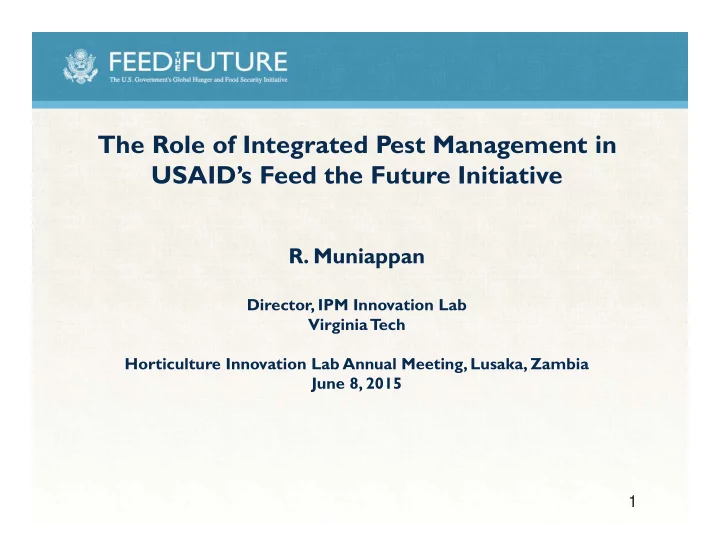

The Role of Integrated Pest Management in USAID’s Feed the Future Initiative R. Muniappan Director, IPM Innovation Lab Virginia T ech Horticulture Innovation Lab Annual Meeting, Lusaka, Zambia June 8, 2015 1
IPM Innovation Lab Host Countries • Asia – Bangladesh – Nepal – Cambodia – Vietnam • Africa – Ethiopia – Kenya – Tanzania
IPM IL RFAs for the New Program • Exportable fruit crops –Vietnam • Parthenium biocontrol – Ethiopia, Kenya, Tanzania, Uganda • Biodiversity and climate change – Nepal • Modeling of insect dispersal ( Tuta absoluta and groundnut leafminer)– Africa, Asia • Vegetable crops IPM – Bangladesh, Cambodia, Nepal • Rice IPM – Cambodia • Vegetable crops IPM – Ethiopia, Kenya, Tanzania • Rice, Maize and Chickpea IPM – Ethiopia, Kenya, Tanzania
IPM Package for Tomato • Seed or seedling treatment with Trichoderma , Pseudomonas fluorescens, and Bacillus subtilis • Solarization of seed beds and greenhouses • Use of VAM, neem cake and other organics • Selecting virus-resistant varieties • Grafting on resistant rootstock for bacterial wilt, Fusarium and others • Staking and mulching • Yellow sticky traps for thrips, leafminers etc. • Pheromone traps for Helicoverpa and Spodoptera • Host-free period and rogueing for control of virus diseases • Use of Biopesticides such as neem • Use of microbial pesticides such as NPV, Metarhizium , and Beauveria
Coconut pith/dust use in Vegetable seedling production
Trichoderma – a Beneficial Fungus • Its use became very popular in Asia. • IPM Innovation Lab conducted 3 workshops. • Planning to introduce this technology into the African countries.
Trichoderma Production in Bangladesh Trichoderma Production Facility Women producing Trichoderma in their backyard Tricho-leachate Trichoderma Packages for Market
Eggplant and tomato grafting in Bangladesh • Eggplant yield � 249% in Bangladesh • Income � 305% in Bangladesh • Technology transferred from Bangladesh to Ohio • Technology transferred to India, Nepal, Philippines, Uganda, Indonesia, Mali, Senegal, Honduras and Kenya
Bacterial wilt and soil borne pathogen control � Grafting eggplant and tomato on resistant root stock – Bangladesh, Philippines, India, Nepal, Uganda, Kenya, Honduras � Grafting watermelon and cantaloupe on pumpkin rootstock for soil borne disease resistance – South and Southeast Asia � Grafting naranjilla on resistant rootstock, Solanum hirtum – Ecuador � Grafting tree tomato on Solanum auriculatum and Nicotiana glauca - Ecuador
Pheromones for monitoring insect pests
IPM practice in bitter melon crop in Bangladesh • Application of compost with Trichoderma • Setting up cuelure traps • Setting up mashed sweet melon traps • Picking disposal of fruit fly infested fruits • Release of parasitoids Cuelure trap Mashed sweet melon trap Area-wide management of melon fly
NPVs for Spodoptera & Helicoverpa
Production of Parasitoids in Bangladesh
Biocontrol Agents Production in Honduras Orius bug production Predaceous mite collection in the lab Predaceous mite production
Neem Products Neem Tree Neem Flow ers Neem I nsecticide Neem seed extract production
Peanut bud necrosis virus of tom ato • Transm itted by thrips • Com m on in I ndia • Rogueing is effective in controlling this virus Peanut bud necrosis virus- infected tomato Rogued field Unrogued field
Gemini virus control in tomato Virus infected tomato Healthy tomato Tomato yellow leaf curl virus transmitted by white flies primarily Bemisia tabaci Field with host free period Field without host free period Host free period for 3 months is effective in reducing the incidence
Pests of Amaranthus Beat webworm: • Spoladea recurvalis (Lep., Pyralidae) Weevils: • Hypolixus pr. haerens (Col., Curculionidae) • Gasteroclisus pr. rhomboidalis (Col., Curculionidae) • Neocleonus sannio (Col., Curculionidae)
An Invasive Pest, Papaya Mealybug • Origin: Mexico • Spread: • 1990s – Caribbean, Florida and South America • 2001-5 – Micronesia and Hawaii • 2008-9 – India, Indonesia, Malaysia, Thailand, Sri Lanka. •2010-11 –Re Union Island, Ghana, Benin, Nigeria • 2014 – Tanzania, Mauritius, Mozambique
Acerophagus papayae, introduced for control of papaya mealybug in India, resulted in a benefit of $500 Million to 1.34 Billion
Tuta absoluta A native of South America. Introduced to Spain in 2006. Now it has spread in Europe, Mediterranean, Middle East, West and East Africa . Nov. 2014 – Reached India.
Tuta absoluta in Eastern Africa Recorded in Kenya, Tanzania and India in 2014
Spread of Tuta absoluta
Technology Transfer of Trichoderma in Nepal
Groundnut leafminer Groundnut leafminer • A native of Asia • Introduced to Uganda in 1996 • Now covered East and South Africa • IPM IL is working with Peanut and Mycotoxin IL. • IPM IL issued a RFA to model spread of this insect in Africa
Spread of Groundnut leafminer
Pearl millet headminer damage in Niger
Augmentative parasitoid releases � Parasitoids cultured in jute bags and dispersed in millet fields • A set of 15 bags are used to cover 5km 2 area
Thank You
Recommend
More recommend